The Samsung Galaxy Note7 (S820) Review
by Joshua Ho on August 16, 2016 9:00 AM ESTSystem Performance Cont'd
Now that we've covered more general purpose benchmarks that tend to emphasize CPU performance and GPU compute performance, we can look at benchmarks that tend to more strongly emphasize things that games will see benefits from such as improved GPU graphics performance and improved CPU physics processing performance.
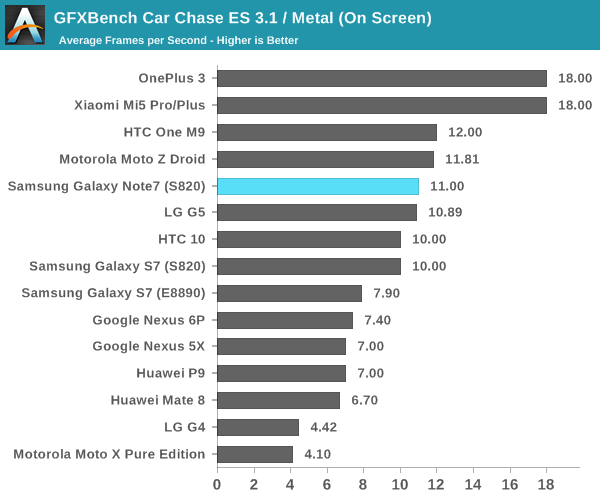
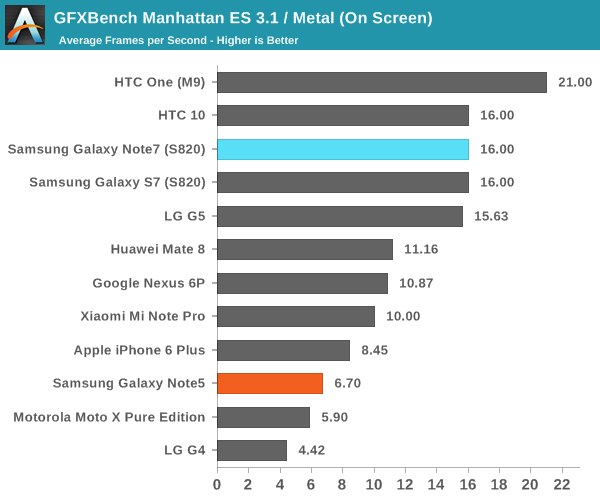
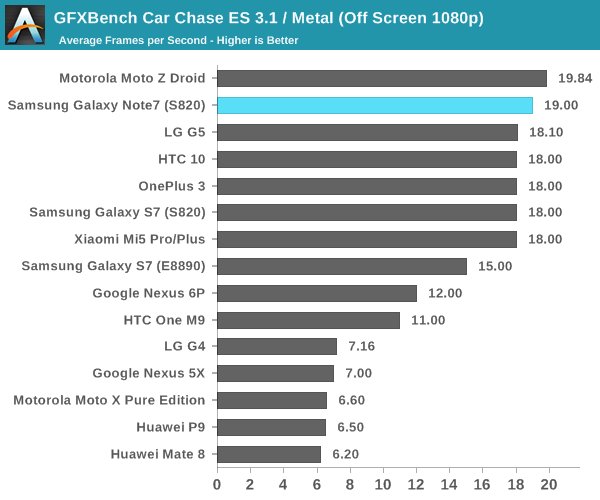
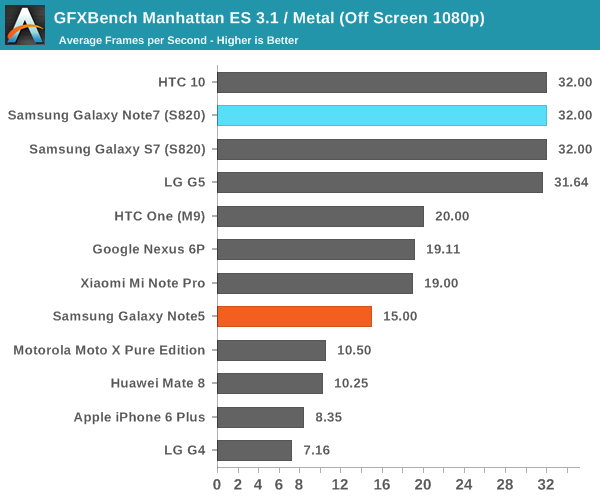

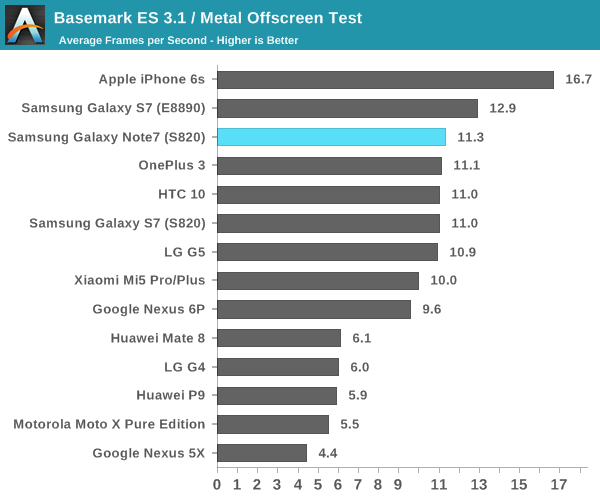
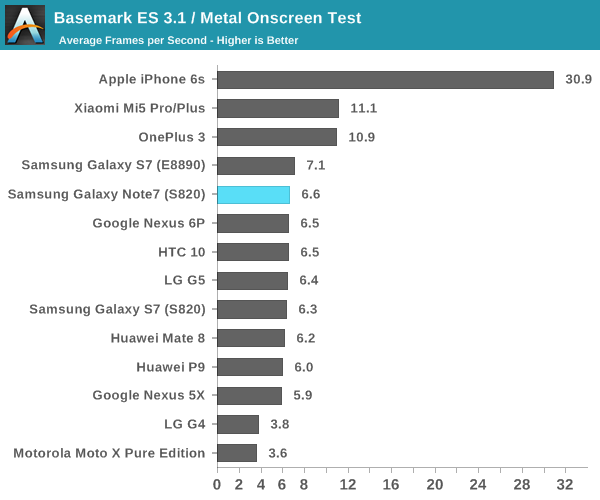
It's probably no surprise, but the Galaxy Note7 performs as expected with the latest drivers and in ideal thermal conditions. The Adreno 530 should be more than sufficient for the forseeable future but for maximum performance it's best to enable 1080p rendering or lower to maximize frame rates in games like Real Racing 3 that tend to really use the GPU to its fullest extent.
NAND Performance
Of course, while Discomark provides a sort of holistic view of performance for a specific task, it’s also important to at least try and break down the various aspects that impact system performance so rather than simple black box testing we can further understand what factors influence performance and therefore provide additional information to make better buying decisions. One of the major contributors to general purpose performance is going to be storage performance, which is often something often ignored by marketing as the nitty gritty details of NAND storage realistically require some background in solid state physics and devices to understand, as well as some understanding of computer science and engineering.
While I’m not really happy with the state of our mobile storage benchmarks, for now I don’t really see another option here as the publicly available storage benchmarks for Android and iOS are fairly basic. Putting aside the state of the benchmarking industry, our current benchmark remains AndroBench 4 which provides at least some basic storage benchmarking capabilities. We use custom settings with this benchmark which attempts to make the test more realistic as the default settings are just wildly unrealistic. This includes adjusting the buffer size, increasing the file size to 100 MB, and only using one thread instead of 8. 256KB file size is targeted as this is the most common block size if you profile this kind of thing for sequential writes and reads, while 4KB block sizes are the most common for other tasks as the vast majority of computer architectures use 4KB pages for virtual memory. Single-threaded I/O is common in most cases because multi-threaded programming is still difficult for most people to reason about in an effective manner because conscious thought is inherently serial in nature with some multiplexing. In addition to this, many eMMC solutions on the market don’t really perform well with multiple threads simultaneously as the controller can’t do anything with extra requests other than reply with a busy signal which already happens with a single thread.
Putting aside discussions of testing we can take a look at the storage solution used in the Galaxy Note7 before getting into the actual results. The Note7 continues to use basically the same storage solution as the Galaxy S7 and S6, which is to say an MLC-based solution that has a UFS Gear 3 single lane interface for bandwidth up to 600 MB/s and basically has the exact same model number if you check the SCSI devices attached to the system save for some changes that indicate the higher 64GB storage relative to the 32GB chips that are most common in the Galaxy S7.
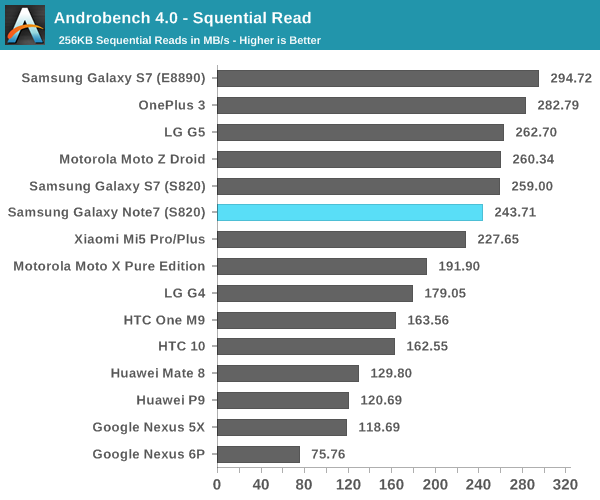

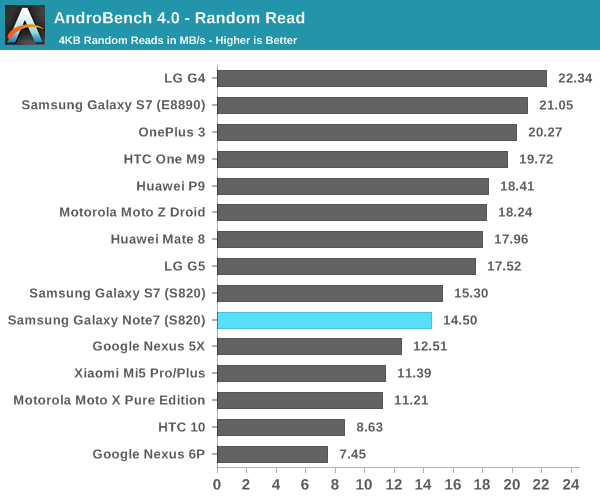
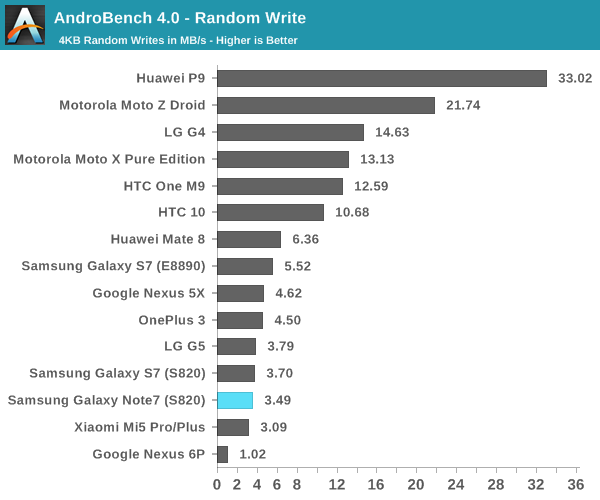
Looking at the test results it performs exactly as quickly as you’d expect from this MLC solution as we’ve tested it in the Galaxy S6, S6 edge, S6 edge+, Note5, S7, S7 edge, and now the Note7 as well as the LG G5. The performance here is acceptable but obviously if you look at burst performance the iPhone 6s has a faster solution due to the hybrid SLC/TLC storage solution. The main benefit of pure MLC NAND is that performance is more consistent as there’s no precipitous drop when the SLC buffer fills. There’s always room to improve but I don’t really see how it’s going to happen unless Samsung moves to V-NAND for the next generation.










202 Comments
View All Comments
Ratman6161 - Tuesday, August 16, 2016 - link
Don't like the icons? Does anyone really care (hint: I don't)? Don't like TouchWiz? Use a different launcher. Ditto with the built in apps. This is one of my reasons for using Android in the first place. If I don't like what the manufacturer supplied, its no problem. Just don't use it. I've got Nova launcher and a standard set of third party apps that I use across all my Android devices that makes them all look and function more or less the same for any thing I do. About the only exceptions are anything related to the S-pen.And refresh the design again? What for? Of course marketing people want constant change so they can convince the uninformed that its "new and improved". Just get rid of the gimmicks like curved screens and call it done. Within the next few years phones are going to be essentially commodities anyway.
polygon_21 - Tuesday, August 16, 2016 - link
Its too bad launchers only change the home screen and the app drawers... you are stuck with touchwiz for the rest of the stufflilmoe - Thursday, August 18, 2016 - link
The thing is, as trivial as the icon complaint is, if he dug just a tiny bit deeper, he'd realize that the new theming engine now supports icon-packs...jospoortvliet - Thursday, August 18, 2016 - link
Sadly I haven't figured out how to disable or delete many of the built in apps...TheCurve - Tuesday, August 16, 2016 - link
Really nicely done, Josh. Made my morning. Cheers!Cod3rror - Tuesday, August 16, 2016 - link
For some reason many modern cameraphones have a real problem rendering vegetation. They all make trees and grass look like it was oil painted. Here's an example from Anandtech's Moto G4 review, the left is OP3 and the right one is MG4+. The left one looks like it was oil painted. http://i.imgur.com/AlXPMap.jpglilmoe - Tuesday, August 16, 2016 - link
You can only do so much with sensors that small, and software that prioritizes speed of capture and processing (since that's what most users want). If you want more, go fully manual.3ogdy - Tuesday, August 16, 2016 - link
It's amazing to see Samsung continue with the same design language introduced with the S6 Edge. Finally a phone that looks different, among a slew of pieces of glass and plastic that look identical. Companies releasing phones that have the same old dog gamn design should be utterly ashamed to put such insults on the market. One could see more variance comparing two dog gamn stones than comparing two "oh-so-new-shiny-awesome-unbelievably-cool-my- s s a <-" smartphones.3ogdy - Tuesday, August 16, 2016 - link
Oh and I couldn't give one fraction of a damn about volumetric efficiency BS. The lack of a removable battery is not a smart choice Samsung has made.I shouldn't have to risk destroying my phone just because I'd like to replace my battery or simply force the phone to turn off if it freezes for whatever the reason. There is no excuse for not including a removable battery. Period.
zeeBomb - Tuesday, August 16, 2016 - link
Back to back phone reviews from anandtech... What a time to be alive